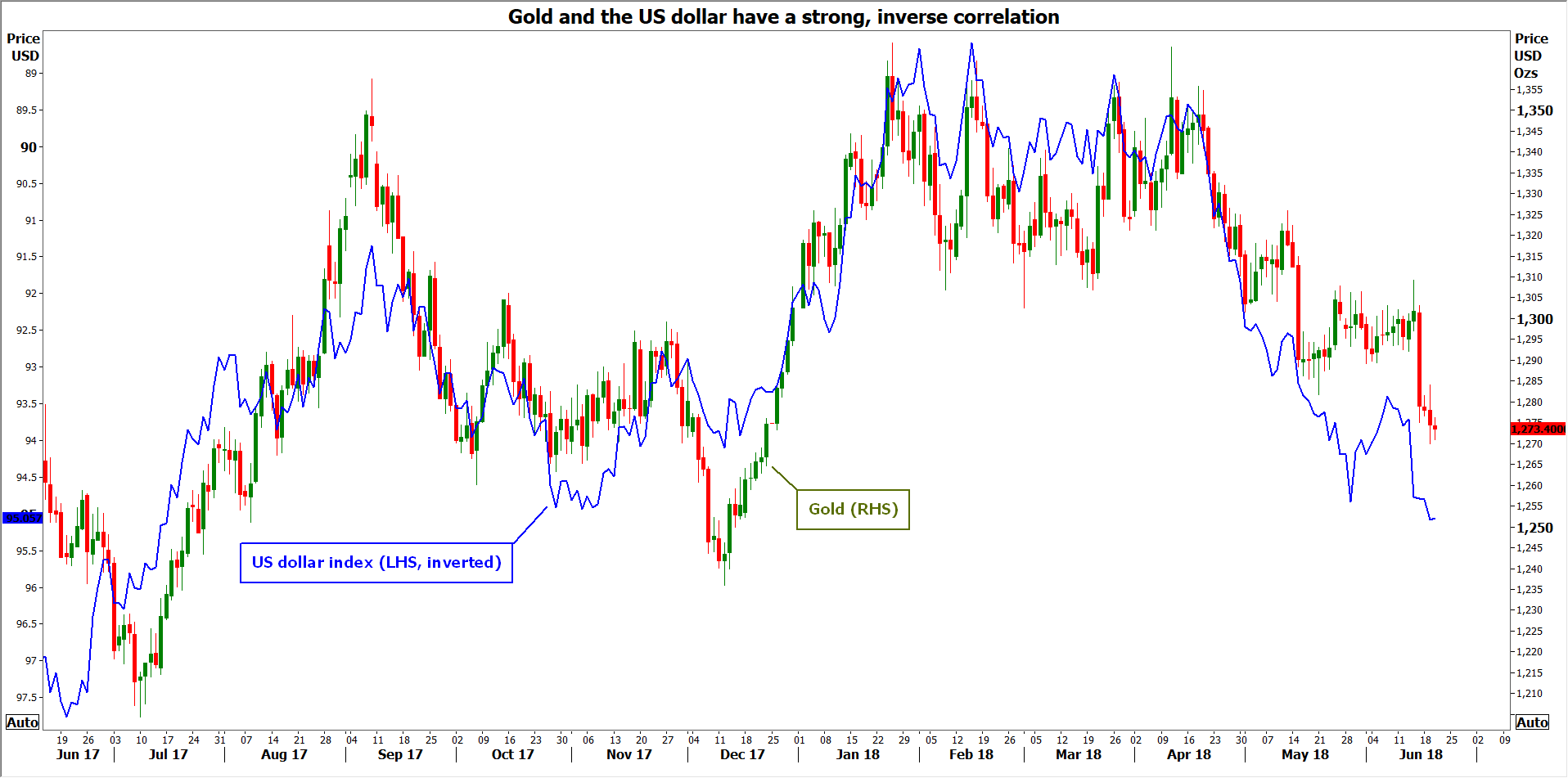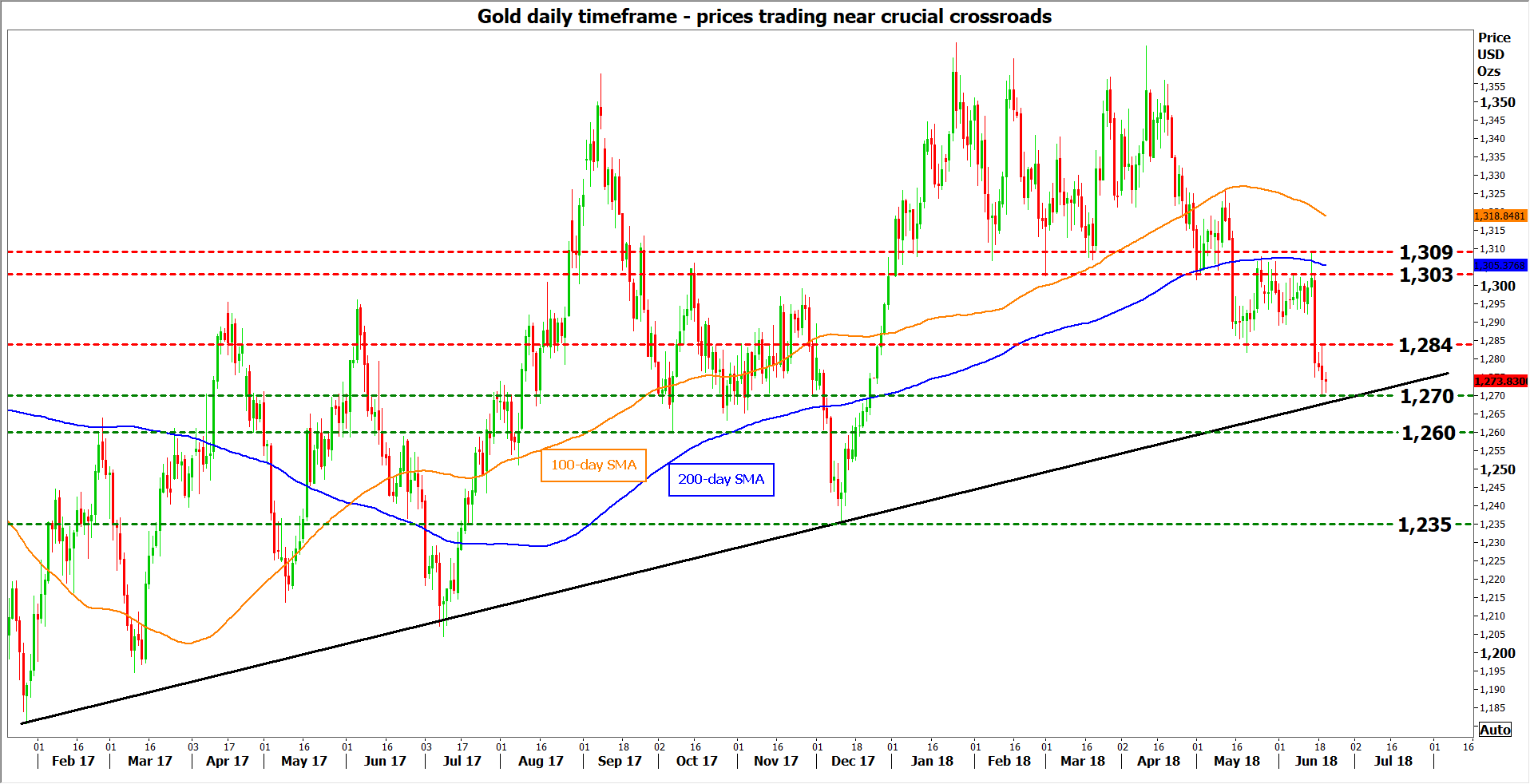After trading in a very narrow range for an entire month, gold prices finally broke lower last week on the back of a stronger dollar, to touch fresh lows for the year. The fact that even the increasingly realistic risk of an “all out” US-China trade war was unable to lift gold suggests that buyers are in short supply right now, and unless tensions escalate much further or the US dollar reverses course, the current pattern may continue.
The overarching theme in financial markets over the past few days has been the rising trade tensions between the world’s two largest economies. After the latest escalation – where the US threatened more tariffs on Chinese goods – markets entered a risk-off pattern, with haven assets like the yen and US bonds coming under demand, while riskier investments like equities sold off. The “odd one out”, however, was gold. Even though the metal is broadly considered a store of value that appreciates in times of turmoil, it actually tumbled this time around to reach new lows for the year, despite increasing signs that dark clouds are gathering over the global economy.
There are a few factors that could explain this “divergence” from gold’s usual pattern of behavior. First and foremost, is the fact that the US dollar continues to hover just below its highs for the year, having staged a spectacular rally in the second quarter. Since gold is priced in dollars, when the greenback appreciates it becomes more expensive for holders of foreign currencies to buy the metal, thus weighing on its demand. This is an inverse relationship that can be best seen graphically (see below), but to provide some context, gold prices are now down 2.2% for the year while the dollar index is up by 2.9%.
Beyond the dollar, it may also be a case of investors tactically liquidating some of their gold exposure in order to raise cash and cover losses in riskier parts of their portfolios, such as in equities – particularly Asian and European ones. On another note, it seems that US bonds may be stealing some of the allure that gold has traditionally enjoyed. Following this year’s surge in Treasury yields, US bonds have become much more attractive to hold relative to metals like gold, which not only pay no interest to hold, but also carry storage costs. Thus, it may be that in an environment of higher yields but still relatively subdued inflation, Treasuries are currently “outshining” gold.
More broadly, the fact that gold prices have failed to gain even amid a plethora of discouraging developments this year – ranging from trade risks to European political worries – suggests that buyers are currently in short supply. Unless the dollar reverses course and starts correcting lower, or the situation on the trade front escalates to an all-out “war”, one feels hesitant to call for a serious rebound in gold. There are of course other catalysts that could help prices recover, such as a sudden heat-up in geopolitical tensions outside the realm of trade. At present, though, nothing on that front appears major enough to trigger a shift in gold sentiment.
Technically, the bears have the advantage over a medium-term timeframe, but the outlook remains somewhat positive over the long-term, for now. To explain – following the sharp drop on June 15, the medium-term picture has turned decisively negative, as prices are posting lower highs and lower lows while also trading well-below their 100 and 200-day moving averages. However, the fact that the metal is still trading above an uptrend line taken from the low of 27 January 2017, keeps the longer-term outlook cautiously positive. A decisive break below that upside support line is needed for the broader picture to turn negative too.
In terms of key levels to watch, the most crucial area may be the crossroads of the 1270 support territory and the aforementioned long-term uptrend line. Should the bears manage to break below it, that could set the stage for further declines, initially towards the October 6 trough of 1260. Further below, the December 12 bottom of 1235 would increasingly come into view.
On the upside, immediate resistance could be met around the 1284 figure, which capped the advance on June 19. An upside break could open the way for the 1303 territory, with the area around it also encapsulating the round figure of 1300. Even higher, advances could stall near the June 14 peak of 1309.
Forex trading and trading in other leveraged products involves a significant level of risk and is not suitable for all investors.
Recommended Content
Editors’ Picks
EUR/USD retreats toward 1.0650 after PMI-inspired rebound

EUR/USD loses traction and retreats to the 1.0650 area after rising toward 1.0700 with the immediate reaction to the upbeat PMI reports from the Eurozone and Germany. The cautious market stance helps the USD hold its ground ahead of US PMI data.
GBP/USD fluctuates near 1.2350 after UK PMIs

GBP/USD clings to small daily gains near 1.2350 in the European session on Tuesday. The data from the UK showed that the private sector continued to grow at an accelerating pace in April, helping Pound Sterling stay resilient against its rivals.
Gold flirts with $2,300 amid receding safe-haven demand

Gold (XAU/USD) remains under heavy selling pressure for the second straight day on Tuesday and languishes near its lowest level in over two weeks, around the $2,300 mark in the European session. Eyes on US PMI data.
Here’s why Ondo price hit new ATH amid bearish market outlook Premium

Ondo price shows no signs of slowing down after setting up an all-time high (ATH) at $1.05 on March 31. This development is likely to be followed by a correction and ATH but not necessarily in that order.
US S&P Global PMIs Preview: Economic expansion set to keep momentum in April

S&P Global Manufacturing PMI and Services PMI are both expected to come in at 52 in April’s flash estimate, highlighting an ongoing expansion in the private sector’s economic activity.

